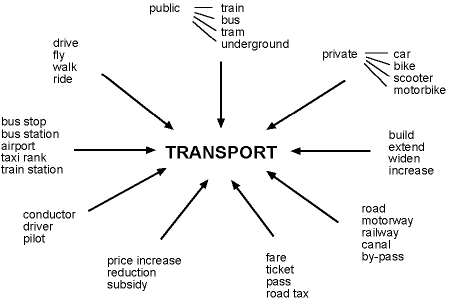How can I draw on students' background knowledge?
Module 7, section 1.4, explains the importance of existing schemata or background knowledge in reading comprehension. A simple way to exploit schemata and background knowledge, requiring very little preparation, is brainstorming. The teacher gives students a title or key word, and the group has to call out ideas, concepts and words that they associate with the title or key word. The teacher categorizes students' random suggestions on the board or OHP and creates a semantic map (see Module 10 on Vocabulary) with the aim of prompting an appropriate classification and promoting learners' comprehension of the text. For example, with the key word 'transport', words might be grouped as follows:

Figure 8.3 Brainstorming activity to activate background knowledge
Another way to exploit existing background knowledge is to present students with a narrative or description of something with which they are already familiar from their L1. Reading a well-known joke in French, the German version of 'Three Little Pigs', or a Spanish description of Britain's transport system all draw on existing background knowledge. In the first two cases, the reader will be familiar with the structure of the narrative, while in the third the subject matter will usually be well known and a context provided for reliable guessing of unfamiliar vocabulary.
If you have access to two well-known stories or fairy tales in the target language, give learners a jumbled set of key phrases, ask them to sort out which text each phrase belongs to and to guess the title of the story/tale. For example:
|
a wolf
looked in the mirror
mother waved goodbye
|
Advanced learners might be asked to provide some of these key phrases themselves prior to reading and to use the first reading of the text proper to confirm or amend their suggestions.
Even when students are not familiar with the narrative itself, for example when working on factual texts relating to the target country, you can encourage them to predict the likely content based on what they know in general about the topic and its likely implications. For instance, on a text about reactions to the increasing number of new motorways being built in southern Spain, you might ask learners to predict residents' concerns (encourages more cars, pollution, noise, house prices falling, wildlife affected, etc).
Similarly, students might be asked to draw on knowledge of their own culture or on relevant general knowledge. Two texts in the Text Bank provide good examples of this. In Text 15 ('Mehr Freiheit für alle!') students are encouraged to answer the following questions in advance of reading:
|
In Text 16 ('Informationen für Familien') learners are asked to perform the following preliminary task:
|
In groups, discuss what the state can do to help parents bring up their children. Compare the results of your discussion in a plenary session. |
Alternatively, students might be asked to draw on their knowledge of aspects of the target culture. For example, Mitchell and Swarbrick (1994) suggest that with a text about the differences between French and English schools, students could be asked, before reading, to consider the list below and work out which statement applies to which country. When they come to read the text, they compare their predictions with what the author says and decide whether or not they agree:
|
il y a beaucoup d'activités extra-scolaires on a beaucoup de devoirs
les cours finissent a trois heures et demie
les cours finissent a
cinq heures
beaucoup d'uniformes! |
(Slightly adapted from Mitchell and Swarbrick, 1994: 27)
ACTIVITY 6
|
Read Text 2, 'The Architecture of Consumption', and consider how you might encourage students to make use of their existing background knowledge before they read the text. Click on 'Commentary' and compare your suggestion with the approach outlined there. |